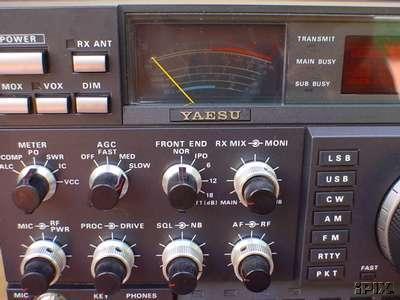

 | |||
 | |||
Classic Masterpiece Series: Chapter One © 2005 Vertex Standard USA, Inc.
FT-1000D: The First of the New-Generation Elite-Class YAESU Rigs! The FT-1000D, introduced in late 1989, was the first in a totally new generation of elite-class, competition-grade transceivers from the design team at YAESU. With prime focus on outstanding receiver performance, the design team also crafted the first 200-Watt transceiver in recent years, and its superb ergonomics combined with the advanced design to yield a transceiver that, fifteen years later, is still an all-time favorite of DX and contest operators. Design Concept The FT-1000D was crafted, above all, to be the best transceiver an owner had ever experienced, period. Extensive work was done in the receiver design, elevating the Dynamic Range and Blocking bar far above the level previously seen in the Amateur industry. Indeed, QST Magazine remarked, in their March, 1991 Product Review, “. . .it has the best overall performance (in terms of sensitivity and dynamic range), and the highest third-order intercept of any commercial radio ever tested in the ARRL Lab.” Of greater significance to many operators, the FT-1000D was clean, with no odd “artifacts” from over-processing or poor consideration of phase distortion through the filters. With the FT-1000D, you always knew that, if you couldn’t hear them, they really weren’t there! The cascaded eight-pole crystal filters provided a degree of IF selectivity not available elsewhere; in conjunction with the innovative Width/Shift controls, almost unlimited adjustment of the receiver passband was provided for the operator. And, for CW, a highly-effective Audio peaking Filter (APF) allowed a very weak signal to be brought up out of the noise to a level of solid copy. A high point of the FT-1000D design was the incorporation of Dual Receive. A capability not seen in Amateur Radio since the days of the old Signal One transceivers, Dual Receivers instantly separated the FT-1000D from the rest of the industry. With separate antenna inputs for each receiver, one could listen on 40 and 10 meters at the same time, or, alternative, press the “A=B” button and listen to one signal using one vertical and one horizontal antenna, thus effectively eliminating the fading effects of polarization change on the incoming signal. On transmit, the 30-Volt power amplifier system put out a solid 200 Watts, with an RF clipping-type Speech Processor providing a useful boost in talk power. Four separate drive chain controls (MIC GAIN, PROC, DRIVE, and RF PWR) afforded the user precise adjustment capability within the ALC loop. And in operation, the keyboard frequency entry, ease of accessing memories, and the overall clean front panel layout made operating the FT-1000D a breeze. Moreover, the FT-1000D has a solid “feel” that simply exuded the (rightly deserved) image of quality. This rig was, and still is, a gem. Early DX-citement In 1989, just before production of the FT-1000D started, it was the featured transceiver in the 4J1FS joint USSR-Finland-USA DX-pedition to M-V Island, located northwest of what was then called Leningrad. Yaesu USA’s Chip Margelli, K7JA, was the sole American member of the international team.
Production True to its character as an enduring model, the FT-1000D stayed in production for over a decade. Truly the highest level that we felt that an “analog-only” radio could reasonably achieve, the FT-1000D was not challenged in the marketplace by competing models, and we couldn’t make a better analog radio ourselves. So the FT-1000D stayed in the YAESU HF lineup until 2003, when we determined that this champion radio had finally run its course. Evolution The only additional model in the “FT-1000 Series” was the FT-1000 with no appended letter. This was a moderately stripped-down version, without the additional bandpass filter unit affording split-band dual receive; several IF filters and other accessories were also cast as “options” to allow the user to mix-and match the configuration inside the radio, saving money in the process. Of course, the FT-1000D series later gave rise to the FT-1000MP, a legacy radio dedicated to the memory of the founder of Yaesu Musen Co., Ltd., Mr. S. Hasegawa (JA1MP). Mr. Hasegawa regrettably passed away just three years into the production of the FT-1000D, but his vision in making the commitment to production of the FT-1000 series lives on today, throughout the YAESU product line. Further Reading If you’d like to read more about the FT-1000D, visit our Web site. The host site is www.vertexstandard.com, and you may click on “Amateur Products” on the right side to get to the YAESU Amateur Products page. The direct link to the FT-1000D is: http://www.yaesu.com/indexVS.cfm?cmd=DisplayProducts&ProdCatID=102&encProdID=MRfvliww6fI%3D&DivisionID=65&isArchived=1 Cut and paste this link into your Web browser; here you will find the FT-1000D brochure, Operating Manual, and a host of other information about this true Classic Masterpiece in the YAESU line. We hope you’ve enjoyed this first chapter in a tour through the annals of YAESU product history. Watch for more such articles in the future, right here on the WDXC Web site!
| ||
 | ||
|
|
 |